Monthly Updates on Recent Books in the History of Christianity
To raise awareness of recent books in the history of Christianity, the editorial staff of Church History: Studies in Christianity and Culture highlights each month a list of 10-15 books in diverse periods and geographical regions that we hope will be of interest to our members. We include here below the eighth monthly list, chosen by our staff, with excerpts from the publishers’ blurbs.
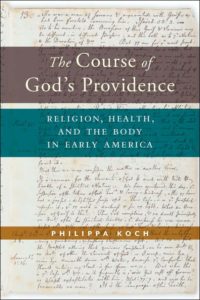
Philippa Koch, The Course of God’s Providence: Religion, Health, and the Body in Early America. 2021
The COVID-19 pandemic has demonstrated the power of narrative during times of sickness and disease. As Americans strive to find meaning amid upheaval and loss, some consider the nature of God’s will. Early American Protestants experienced similar struggles as they attempted to interpret the diseases of their time.
In this groundbreaking work, Philippa Koch explores the doctrine of providence—a belief in a divine plan for the world—and its manifestations in eighteenth-century America, from its origins as a consoling response to sickness to how it informed the practices of Protestant activity in the Atlantic world. Drawing on pastoral manuals, manuscript memoirs, journals, and letters, as well as medical treatises, epidemic narratives, and midwifery manuals, Koch shows how Protestant teachings around providence shaped the lives of believers even as the Enlightenment seemed to portend a more secular approach to the world and the human body.
Their commitment to providence prompted, in fact, early Americans’ active engagement with the medical developments of their time, encouraging them to see modern science and medicine as divinely bestowed missionary tools for helping others. Indeed, the book shows that the ways in which the colonial world thought about questions of God’s will in sickness and health help to illuminate the continuing power of Protestant ideas and practices in American society today.
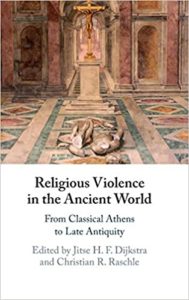
Jtse H.F. Dijkstra and Christian R. Raschle, eds. Religious Violence in the Ancient World: From Classical Athens to Late Antiquity. 2020
Much like our world today, Late Antiquity (fourth-seventh centuries CE) is often seen as a period rife with religious violence, not least because the literary sources are full of stories of Christians attacking temples, statues and 'pagans'. However, using insights from Religious Studies, recent studies have demonstrated that the Late Antique sources disguise a much more intricate reality. The present volume builds on this recent cutting-edge scholarship on religious violence in Late Antiquity in order to come to more nuanced judgments about the nature of the violence. At the same time, the focus on Late Antiquity has taken away from the fact that the phenomenon was no less prevalent in the earlier Graeco-Roman world. This book is therefore the first to bring together scholars with expertise ranging from classical Athens to Late Antiquity to examine the phenomenon in all its complexity and diversity throughout Antiquity.
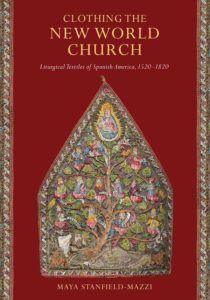
Maya Stanfield-Mazzi, Clothing the New World Church: Liturgical Textiles in Spanish America, 1520-1820. 2021
University of Notre Dame Press
When Catholic churches were built in the New World in the sixteenth century, they were furnished with rich textiles known in Spanish as “church clothing.” These textile ornaments covered churches’ altars, stairs, floors, and walls. Vestments clothed priests and church attendants, and garments clothed statues of saints. The value attached to these textiles, their constant use, and their stunning visual qualities suggest that they played a much greater role in the creation of the Latin American Church than has been previously recognized. In Clothing the New World Church, Maya Stanfield-Mazzi provides the first comprehensive survey of church adornment with textiles, addressing how these works helped establish Christianity in Spanish America and expand it over four centuries. Including more than 180 photos, this book examines both imported and indigenous textiles used in the church, compiling works that are now scattered around the world and reconstructing their original contexts. Stanfield-Mazzi delves into the hybrid or mestizo qualities of these cloths and argues that when local weavers or embroiderers in the Americas created church textiles they did so consciously, with the understanding that they were creating a new church through their work.
The chapters are divided by textile type, including embroidery, featherwork, tapestry, painted cotton, and cotton lace. In the first chapter, on woven silk, we see how a “silk standard” was established on the basis of priestly preferences for this imported cloth. The second chapter explains how Spanish-style embroidery was introduced in the New World and mastered by local artisans. The following chapters show that, in select times and places, spectacular local textile types were adapted for the church, reflecting ancestral aesthetic and ideological patterns. Clothing the New World Church makes a significant contribution to the fields of textile studies, art history, Church history, and Latin American studies, and to interdisciplinary scholarship on material culture and indigenous agency in the New World.
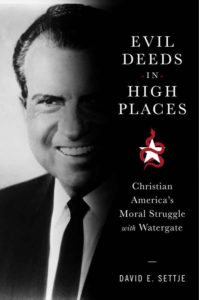
David E. Settje, Evil Deeds in High Places: Christian America’s Moral Struggle with Watergate. 2020
The Watergate scandal was one of the most infamous events in American democratic history. Faith in the government plummeted, leaving the nation feeling betrayed and unsure who could be trusted anymore. In Evil Deeds in High Places, David E. Settje examines how Christian institutions reacted to this moral and ethical collapse, and the ways in which they chose to assert their moral authority.
Settje argues that Watergate was a turning point for spurring Christian engagement with politics. While American Christians had certainly already been active in the public sphere, these events motivated a more urgent engagement in response, and served to pave the way for conservatives to push more fully into political power.
Historians have carefully analyzed the judicial, media, congressional, and presidential actions surrounding Watergate, but there has been very little consideration of popular reactions of Americans across the political spectrum. Though this book does not aspire to offer a comprehensive picture of America’s citizenry, by examining the variety of Protestant Christian experiences—those more conservative, those more liberal, and those in between—and by incorporating analyses of both white and black Christian reactions, it captures a significant swath of the American population at the time, providing one of the only studies to examine how everyday Americans viewed the events of Watergate.
Grasping the dynamics of Christian responses to Watergate enables us to comprehend more completely that volatile moment in US history, and provides important context to make sense of reactions to our more recent political turmoil.
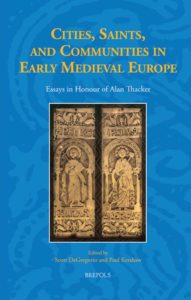
Scott DeGregorio and Paul Kershaw, eds. Cities, Saints, and Communities in Early Medieval Europe: Essays in Honour of Alan Thacker. 2020
This book honours the scholarship of English historian Dr. Alan Thacker by exploring the insular, the European and, more broadly, the Mediterranean connections and contexts of the history and culture of Anglo-Saxon England in the age of Bede, and beyond. It brings together original contributions by leading European and North American scholars of Late Antiquity and the early Middle Ages working across a range of disciplines: history, theology, epigraphy, and art history. Moving from the Irish Sea to the Bosporus, this collection presents a linked world in which saints, scholars, and the city of Rome all played powerful connective roles, creating communities, generating relationships, linking east to west, north to south, and present to past.
As in Thacker’s own work, Bede’s life and thought is a central presence. Bede’s attitudes to historical and contemporaneous conceptions of heresy, to the Irish church, and the evidence for his often complex relationships with his Northumbrian contemporaries all come under scrutiny, together with groundbreaking studies of his exegesis, christology, and historical method. Many of the contributions offer original insights into figures and phenomena that have been the focus of Dr. Thacker’s highly influential scholarship.

David Malkiel, Strangers in Yemen: Travel and Cultural Encounter among Jews, Christians, and Muslims in the Colonial Era. 2021
Strangers in Yemen is a study of travel to Yemen in the nineteenth century by Jews, Christians and Muslims. The travelers include a missionary, artist, scientist, rabbi, merchant, adventurer and soldier. The focus is on the encounter between people of different cultures, and the chapters analyze the travelers’ accounts to elucidate how strangers and locals perceived each other, and how the experiences shaped their perceptions of themselves. Cultural encounter is among the most important challenges of our time, a time of global migration and instant communication. Today, as in the past, history provides a valuable tool for illuminating the human experience, and this scholarly work stimulates us to contemplate the challenge of cultural encounter, for it affects us all.

Thomas Fulton, The Book of Books: Biblical Interpretation, Literary Culture, and the Political Imagination from Erasmus to Milton. 2021
University of Pennsylvania Press
Just as the Reformation was a movement of intertwined theological and political aims, many individual authors of the time shifted back and forth between biblical interpretation and political writing. Two foundational figures in the history of the Renaissance Bible, Desiderius Erasmus and William Tyndale, are cases in point, one writing in Latin, the other in the vernacular. Erasmus undertook the project of retranslating and annotating the New Testament at the same time that he developed rhetorical approaches for addressing princes in his Education of a Christian Prince (1516); Tyndale was occupied with biblically inflected works such as his Obedience of a Christian Man (1528) while translating and annotating the first printed English Bibles.
In The Book of Books, Thomas Fulton charts the process of recovery, interpretation, and reuse of scripture in early modern England, exploring the uses of the Bible as a supremely authoritative text that was continually transformed for political purposes. In a series of case studies linked to biblical translation, polemical tracts, and works of imaginative literature produced during the reigns of successive English rulers, he investigates the commerce between biblical interpretation, readership, and literary culture. Whereas scholars have often drawn exclusively on modern editions of the King James Version, Fulton turns our attention toward the specific Bibles that writers used and the specific manner in which they used them. In doing so, he argues that Spenser, Shakespeare, Milton, and others were in conversation not just with the biblical text itself, but with the rich interpretive and paratextual structures that accompanied it, revolving around sites of social controversy as well as the larger, often dynastically oriented conditions under which particular Bibles were created.
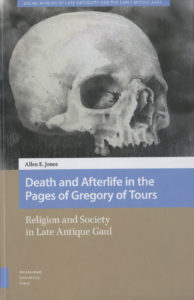
Allen E. Jones, Death and Afterlife in the Pages of Gregory of Tours: Religion and Society in Late Antique Gaul. 2020
Gregory of Tours was a bishop of late antiquity who was famously devoted to promoting the efficacy of saintly powers. In his writings, both historical and hagiographical, Gregory depicted the saints and reprobates of his age. This book analyses Gregory’s writings about death and the afterlife, thereby illuminating the bishop’s pastoral imperative to save souls and revealing his opinions about the fates of Merovingian royals, among many others he mentions in his voluminous text. The study provides insight into Gallic peoples living at the dawning of the Middle Ages and their hopes and fears about the otherworld. It affords an original, nuanced interpretation of Gregory’s motives for penning his works, particularly the Historiae, which remained unfinished upon the author’s death.
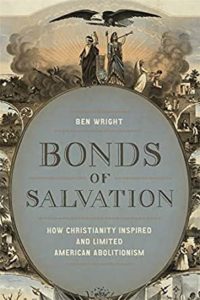
Ben Wright, Bonds of Salvation: How Christianity Inspired and Limited American Abolitionism. 2020
Louisiana State University Press
Ben Wright’s Bonds of Salvation demonstrates how religion structured the possibilities and limitations of American abolitionism during the early years of the republic. From the American Revolution through the eruption of schisms in the three largest Protestant denominations in the 1840s, this comprehensive work lays bare the social and religious divides that culminated in secession and civil war. Historians often emphasize status anxieties, market changes, biracial cooperation, and political maneuvering as primary forces in the evolution of slavery in the United States. Wright instead foregrounds the pivotal role religion played in shaping the ideological contours of the early abolitionist movement.

Jenna Supp-Montgomerie, When the Medium Was the Mission: The Atlantic Telegraph and the Religious Origins of Network Culture. 2021
The advent of a telegraph cable crossing the Atlantic Ocean was viewed much the way the internet is today, to herald a coming world-wide unification. President Buchanan declared that the Atlantic Telegraph would be “an instrument destined by divine providence to diffuse religion, civilization, liberty, and law throughout the world” through which “the nations of Christendom [would] spontaneously unite.” Evangelical Protestantism embraced the new technology as indicating God’s support for their work to Christianize the globe. Public figures in the US imagined this new communication technology in primarily religious terms as offering the means to unite the world and inspire peaceful relations among nations. Religious utopianists saw the telegraph as the dawn of a perfect future.
Religious framing thus dominated the interpretation of the technology’s possibilities, forging an imaginary of networks as connective, so much so that connection is now fundamental to the idea of networks. In reality, however, networks are marked, at core, by disconnection. With lively historical sources and an accessible engagement with critical theory, When the Medium was the Mission tells the story of how connection was made into the fundamental promise of networks, illuminating the power of public Protestantism in the first network imaginaries, which continue to resonate today in false expectations of connection.
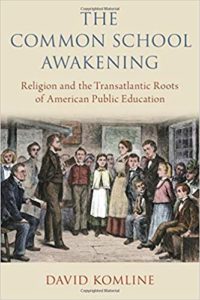
David Komline, The Common School Awakening: Religion and the Transatlantic Roots of American Public Education. 2020
A statue of Horace Mann, erected in front of the Boston State House in 1863, declares him the "Father of the American Public School System." For over a century and a half, most narratives about early American education have taken this epithet as the truth. As Mann looms over the Boston Common, so he has also loomed over discussions of early American schooling. Other scholarship has emphasized economic factors as the main reason for the emergence of public schools. The Common School Awakening offers a new narrative about the rise of public schools in America that counters these conceptions.
In this book, David Komline explains how a broad and distinctly American religious consensus emerged in the first half of the nineteenth century, allowing people from across the religious spectrum to cooperate in systematizing and professionalizing America's schools in an effort to Christianize the country. At the height of this movement, several states introduced state-sponsored teacher training colleges and concentrated government oversight of schools in offices such as the one held by Mann. Shortly thereafter, the religious consensus that had served as the foundation for this common school system disintegrated. But the system itself remained, the legacy of not just one man, but of a whole network of reformers who put into motion a transatlantic and transdenominational religious movement - the "Common School Awakening."
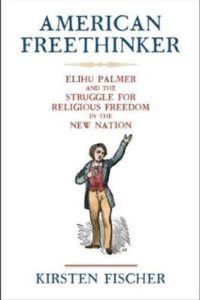
Kirsten Fischer, American Freethinker: Elihu Palmer and the Struggle for Religious Freedom in the New Nation. 2020
University of Pennsylvania Press
When the United States was new, a lapsed minister named Elihu Palmer shared with his fellow Americans the radical idea that virtue required no religious foundation. A better source for morality, he said, could be found in the natural world: the interconnected web of life that inspired compassion for all living things. Religions that deny these universal connections should be discarded, he insisted. For this, his Christian critics denounced him as a heretic whose ideas endangered the country.
Although his publications and speaking tours made him one of the most infamous American freethinkers in his day, Elihu Palmer has been largely forgotten. No cache of his personal papers exists and his book has been long out of print. Yet his story merits telling, Kirsten Fischer argues, and not only for the dramatic account of a man who lost his eyesight before the age of thirty and still became a book author, newspaper editor, and itinerant public speaker. Even more intriguing is his encounter with a cosmology that envisioned the universe as interconnected, alive with sensation, and everywhere infused with a divine life force.
Palmer's "heresy" tested the nation's recently proclaimed commitment to freedom of religion and of speech. In this he was not alone. Fischer reveals that Palmer engaged in person and in print with an array of freethinkers—some famous, others now obscure. The flourishing of diverse religious opinion struck some of his contemporaries as foundational to a healthy democracy while others believed that only a strong Christian faith could support democratic self-governance. This first comprehensive biography of Palmer draws on extensive archival research to tell the life story of a freethinker who was at the heart of the new nation's protracted contest over religious freedom and free speech—a debate that continues to resonate today.
Finally, for staying up-to-date on the latest titles in all fields, we recommend regularly perusing New Books Network and its "New Books in Christian Studies” page. These pages are updated regularly.
